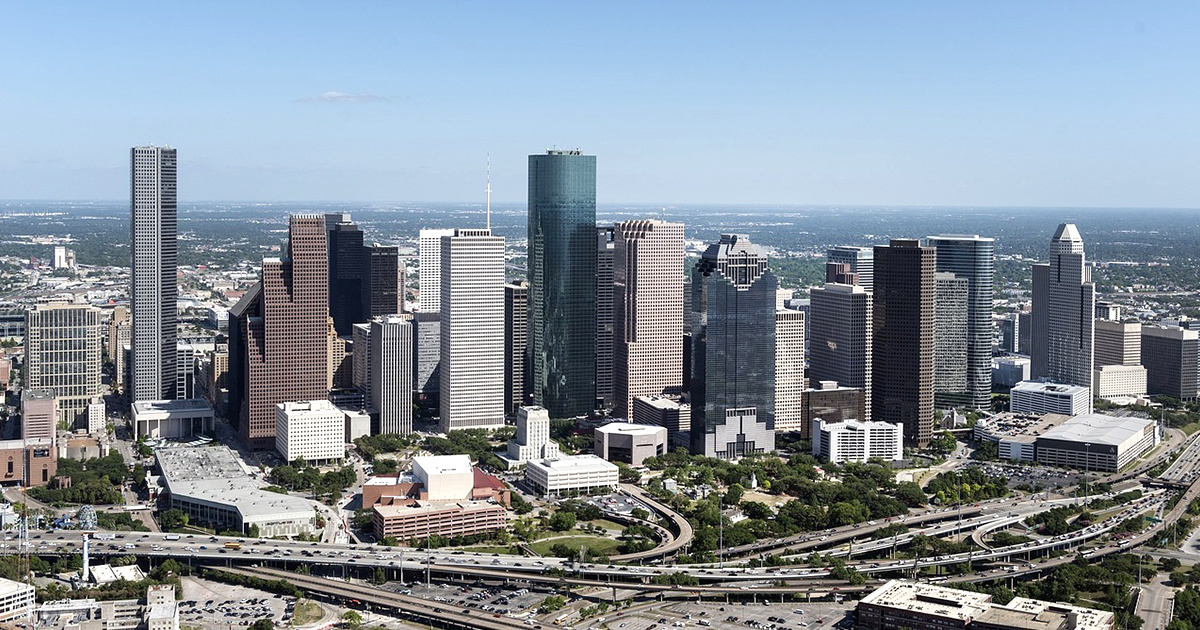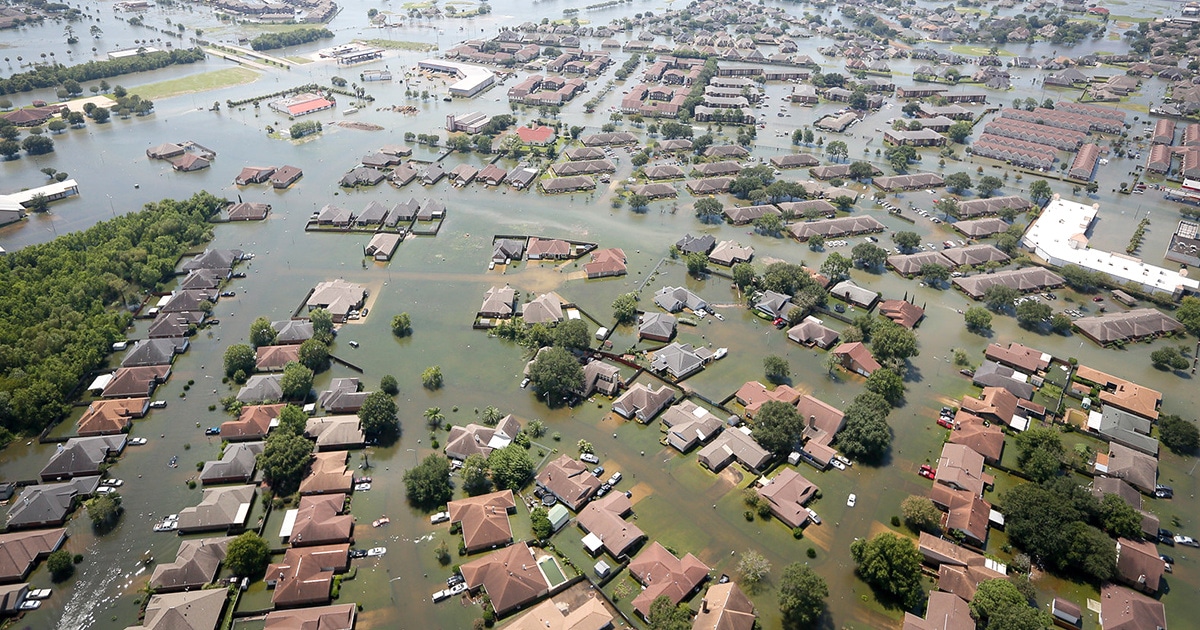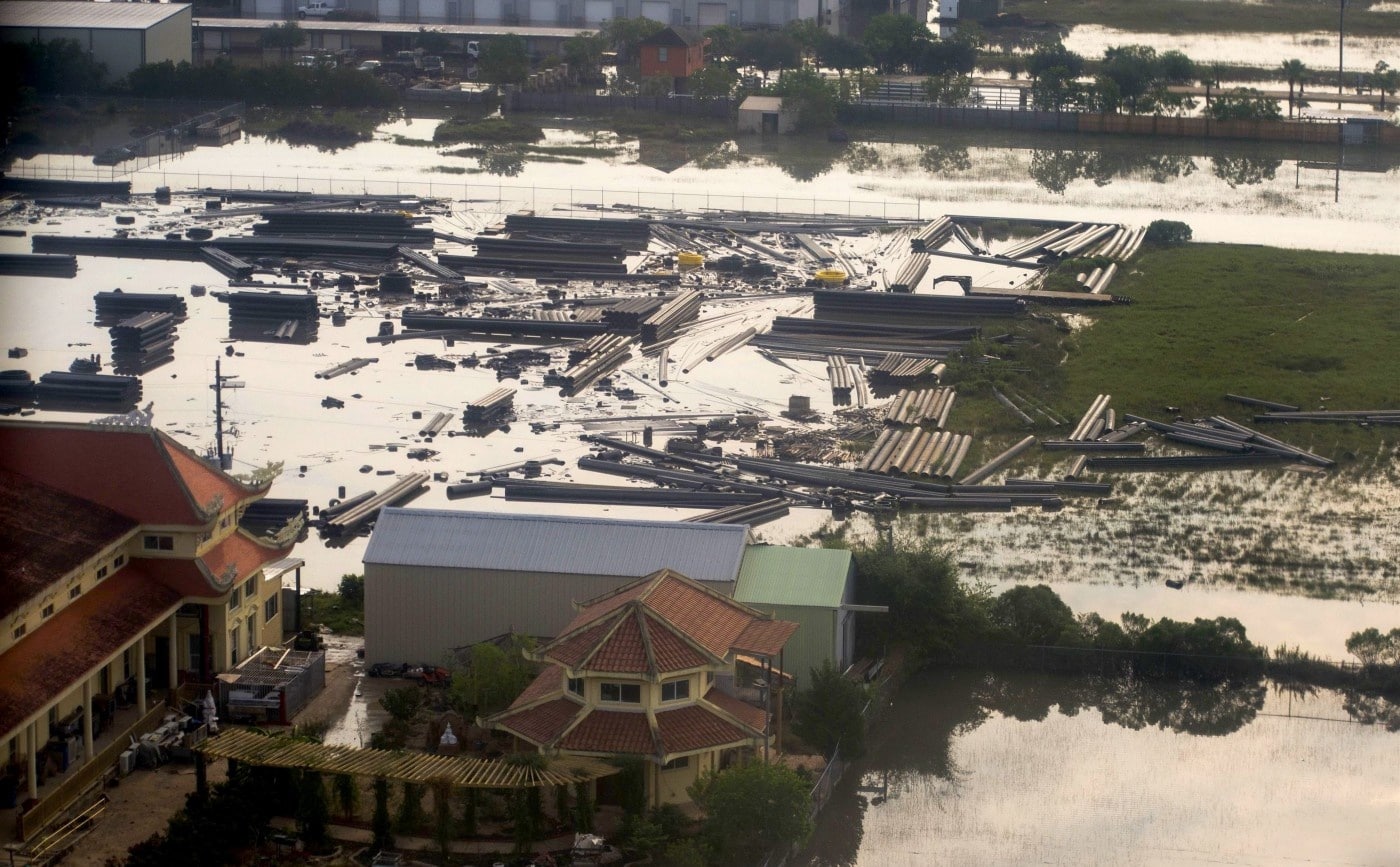

Pixabay
By Molly Taft
It was long predicted that Houston was unprepared for a hurricane like Harvey, yet the storm caught the city off-guard when it landed a year and a half ago.
Harvey dawdled over the region for a week after making landfall, dumping up to five feet of rain on some areas. One study estimates that climate change increased rainfall by as much as 38 percent, and the city’s flood barriers did little to mitigate the catastrophic damage. Beyond the 5 billion in physical damage the storm caused to the region, it also bogged down the city’s criminal justice system, making the city’s courts and jails more inefficient, and with serious consequences.
The Harris County Criminal Justice Center, which sits a block away from the Buffalo Bayou, acts as a central nervous system for criminal justice proceedings in the country’s third-largest county. Harvey hit the courthouse with a one-two punch, as four feet of floodwater damaged the lower levels and increased water pressure burst pipes on higher floors.
When a courthouse that serves 4.5 million people is damaged, an already backed-up legal system gets even more inefficient. The city was forced to close the building after water damage knocked out 40 courtrooms on the center’s 20 floors. Jury trials were delayed as the district scrambled to find spaces to hold court. Most hearings in subsequent months took place in the crowded jail basement, where prosecutors, defenders and their clients were forced into close quarters in the limited space available.
“There’s two old classrooms down there that they turned into courtrooms,” defense attorney Nathan Hennigan said. “I mean, it didn’t serve as a court. Basically, all you can do is enter pleas and things like that. Obviously, you can’t have a trial or anything down there.”
“Harvey kind of highlighted some of the problems” with the city’s jails, said Eric Davis, a trial chief at Houston’s Public Defender Office. The sudden slowdown in court cases from the storm hit a city that was already struggling with its jail population and practices. The Harris County Jail had faced chronic overcrowding for years, while judges in the Houston courts had long been accused of using the county’s cash bail system to trap poor defendants accused of misdemeanors and minor crimes unfairly behind bars.
In 2016, inmates in the jail filed suit against the county alleging unconstitutional bail practices. Months before the storm in 2017, a federal judge sided with the inmates. “Harris County’s policy is to detain indigent misdemeanor defendants before trial, violating equal protection rights against wealth-based discrimination and violating due process protections against pretrial detention,” the judge wrote in her decision.
When Harvey blew in and limited court space, it collided with Houston’s slow reform process, impacting hundreds of cases. “I’ve got defendants who have been in jail five, six years waiting on trial. I saw a case where a guy has 1800 days [served],” Davis said. “He had been in jail a long time before Harvey hit. Then Harvey hit and delayed [his trial] even more.”
In April, the Houston Chronicle profiled some of the county’s 25 longest-jailed inmates awaiting trial, who have collectively served 107 years in jail. Keith Allen Smith, who was accused in 2015 of murder, couldn’t afford the ,000 bail set in his case and was only acquitted this year after serving nearly four years in the Harris County Jail. His lawyer cited damage from Hurricane Harvey as one of the “key reasons” Smith’s trial date kept being postponed.
The jail basement served as the main courtroom for more than a year, Hennigan said, causing significant lags in the system. “There wasn’t anywhere to try cases,” he said. “If cases aren’t getting tried, then people are sitting in jail longer pretrial. People who really shouldn’t be in jail have to stay there longer. People who should be in jail and get sent to prison, they’re not getting sent to prison. Cases are getting reset. Trials are taking place years after an event, which makes it harder for everyone.”
A reasonable timeline on a criminal trial is crucial for the justice system to function, according to Will Snowden, director of the Vera Institute for Justice‘s New Orleans office. Snowden, a former public defender, said that with repeatedly delayed trials, eyewitnesses’ memories can fade, crucial evidence can be lost or misplaced and experts and other witnesses can relocate.
“People’s desire to go to trial diminishes over time,” he said, explaining that those who have been wrongly imprisoned lose patience with lengthy trials. “Sometimes prosecutors would use the fact that this person has been in jail for a year and a half already, and they want to get out.” Defendants exhausted by waiting for trial would often choose to take “sweetheart deals” offered by prosecutors, regardless of their innocence.
Harris County attempted to alleviate some of the pressure by reopening some floors in the criminal justice center in June of last year, but space was still at a premium. For nearly a full year, family and misdemeanor court hearings were held in the old Harris County Family Law Center building across the street, which was scheduled to be torn down before the hurricane. The Family Law Center failed its fire inspection in 2018, so the city hired fire marshals to patrol the hallways daily so that the space could be used. In late May of this year, the courthouse finally fully reopened and dockets resumed on all floors — nearly 20 months after the storm first hit in 2017.

Harvey’s rainfall caused massive flooding, as seen here in Port Arthur, Texas on August 31, 2017 .
Staff Sgt. Daniel J. Martinez / U.S. Air National Guard
“We are on top of each other,” Judge Maria Jackson told the Houston Chronicle in April. “Harvey has had a major impact on the Harris County judiciary — the entire system — and continues to be a problem as long as we double up and work in makeshift areas in several buildings … If we had a courthouse we could occupy full-time, with enough space, that would help to return to some normalcy.”
The courthouse flooding didn’t just slow the speed of trials — it also made things hard for the accused. Floodwaters destroyed holding cells for 900 inmates in the main complex, forcing the county to find a new place for pretrial detainees to live. According to figures provided by the Harris County Sheriff’s Office, 2,763 people awaiting trial were shipped over state lines to a private prison nearly 300 miles away in Louisiana between March and November of 2018.
One of Hennigan’s clients was sent over the state border. “We’re preparing for trial and he’d be gone in Louisiana,” he said. “Then they bring him back, like, two days before trial. You have a hard time communicating with your client because of that.” Hennigan said some attorneys were forced to make the 10-hour round-trip drive to the prison simply to confer with their clients face-to-face.
Houston’s isn’t the only criminal justice system to crumble under extreme weather. As Hurricane Katrina’s floodwaters rose in New Orleans, sheriff deputies abandoned the Orleans Parish Prison, which was filled with defendants awaiting trial for minor offenses. A damning ACLU report published the year after the storm found that inmates — including juveniles moved from other facilities — were left standing in chest-high sewage-contaminated water for days. After the city belatedly sent rescue boats to evacuate the jail, photographs spread of inmates huddled on highways — some of the only surfaces in parts of the city above water — for days in temperatures upwards of 90 degrees F. (Similarly, after Harvey, the state Department of Criminal Justice failed to evacuate several prisons near Houston, leading to horrific conditions for thousands of inmates.)
Problems didn’t stop after the floodwaters subsided. “Inmates got shipped all over the country [before the storm], and there wasn’t an organized mechanism on how to track these folks down after things kind of cleared,” Snowden said. “There really wasn’t a policy in place on how to safely transport some of those individuals before the storm actually hit.”

Fallen water tower in Buras, Louisiana, where Katrina made landfall on August 29, 2005.
EPA
Snowden said that Katrina was the “impetus” for New Orleans to reckon with its flawed criminal justice system. City officials called in outside organizations, including the Vera Institute for Justice, to help. Since the storm, the nonprofit has worked with the city to substantially reduce its jail population. While the city’s jails held roughly 6,500 before Katrina, the population now hovers close to 1,100, after Vera worked with policymakers to implement effective pretrial services. Advocates also successfully pushed to have the jail rebuilt much smaller after the storm, with less than 2,000 beds — putting an automatic cap on the population and committing the city to keeping its numbers down.
Some city officials are continuing to push to build more beds. But a smaller jail population post-Katrina has actually corresponded with a dip in crime rates — helping to “challenge the notion that locking people up keeps us safer,” Snowden said.
“Louisiana has been in prison capital world for many, many decades,” he explained. “If locking people up actually worked, we’d be the safest state in the country. In fact, we [now] have a model where there’s been fewer people in jail and there’s been less crime on the street.”
Even with reforms, Louisiana is still reckoning with the impact of climate change on its criminal justice system. The Louisiana Correctional Institute for Women, the state’s sole prison for women, sits south of Baton Rouge. It flooded during catastrophic rainfall in 2016, which research has shown was directly influenced by a warmer climate. Nearly three years later, roughly 1,000 inmates are still living in overcrowded, “temporary” relocation facilities. Many have no access to basic resources that they’d had in the old prison, like the ability to work a job or eat food in a cafeteria. There’s no sign of when they’ll be able to return to the communities they had built at the old facility.
“If you don’t consider the fact that the past climate is no longer a guide for the future, you risk making investments that are not going to pay back,” said Richard Moss, a climate scientist at the University of Maryland and one of the lead authors of the recent National Climate Assessment. “At worst, you risk making investments that could put people’s health and safety at risk.”
If Texas is to learn any lessons from Harvey, it will be without any guidance from the governor’s office. A commission convened by Republican Gov. Greg Abbott released a 200-page report in December suggesting the state needs to “future-proof” itself due to “changing environmental and human conditions.” The report made no direct mention of climate change, curbing emissions or moving to renewable energy.

Houston’s damage in Harvey’s aftermath on Sept. 3, 2017.
Tech. Sgt. Larry E. Reid Jr. / U.S. Air Force
“I’m not a scientist,” Abbott told reporters at the report’s rollout when asked whether he thought climate change was behind Harvey and projected future disasters. “Impossible for me to answer that question.” In May, bills meant to mandate studies of how climate change will impact Texas died in the state Legislature.
“Climate change is an obvious factor in a lot of these extreme events,” said Moss, who now leads the Science for Climate Action Network, which provides climate science resources to local governments. “Whether it’s explicit or implicit in terms of adaptation, communities are going to need to use climate science.”
This refusal to acknowledge climate impacts will come at the expense of those caught in the criminal justice system in Texas. The county has had experience with a weather-damaged courthouse: Tropical Storm Allison flooded the Criminal Justice Center in 2001, closing it for nearly a year. After Allison, the Houston Chronicle followed the fallout from the lack of space as the courthouse was repaired. In November of 2001, five months after the storm, the Chronicle reported that “prosecutors are cut off from their computers and offices and are juggling witnesses,” while “judges and their staffs are trying to keep up with scheduling and the cases before them.”
It took million to repair the courthouse after Allison, but the recovery from Harvey looks to be a longer slog. Last December, following more than a year of back-and-forth on how to repair Harvey’s damage, the district attorney successfully convinced the city to delay a decision on whether to authorize some repairs to the existing center or rebuild it entirely. Just .9 million of an estimated million in repairs have been approved this year. County engineers say a new structure could cost 0 million and take four years to build.
Even if Houston moves the facility to a less flood-prone area, the city — and others around the country — will still have to contend with other ways that climate change threatens the criminal justice system. Some preliminary research projects that climate change and warming temperatures could help increase crime rates, providing more fodder for an already-clogged courthouse like Harris County’s.
Moss is wary of trying to predict how rising temperatures will affect crime rates, but he said that climate change could interact with other forces to have a “nuanced and complicated” impact on crime.
“The question is, what’s the specific pathway through which climate change alters the existing situation?” Moss said. “If you find that people’s access to basic necessities are being interrupted by climate change, and it’s a question between do they rob a store, or not do so and not feed their family, you’re going to see changes.”
Reposted with permission from our media associate Nexus Media.

 233k
233k  41k
41k  Subscribe
Subscribe 